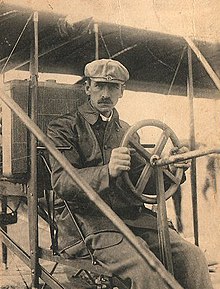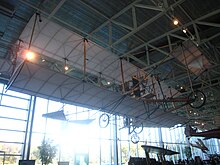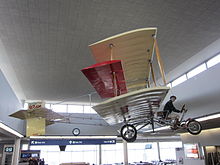Curtiss Model D
| Curtiss Model D | |
|---|---|

| |
| A "headed" Curtiss Model D (Curtiss photo 1916) pusher; later "headless" models incorporated elevators around the rudder in the tail (like most aircraft since). | |
| Role | |
| Manufacturer | Curtiss Aeroplane and Motor Company |
| Introduction | 1911 |
| Status | historic |
| Primary user | Exhibition pilots aeronautical experimenters United States Navy Aeronautical Division, U.S. Signal Corps |
The1911 Curtiss Model D(or frequently "Curtiss Pusher") was an earlyUnited Statespusher aircraftwith theengineand propeller behind the pilot's seat. It was among the first aircraft in the world to be built in any quantity, duringan era of trial-and-error developmentand equally important parallel technical development ininternal combustion enginetechnologies.
It was also the aircraft type which made the first takeoff from the deck of a ship (flown byEugene B. Elyoff the deck ofUSSBirminghamon November 14, 1910, near Hampton Roads, Virginia) and made the first landing aboard a ship (USSPennsylvania) on January 18, 1911, near San Francisco, California.
It was originally fitted with a foreplane for pitch control, but this was dispensed with when it was accidentally discovered to be unnecessary. The new version without the foreplane was known as the Headless Pusher.[1]
Like all Curtiss designs, the aircraft usedailerons,which first existed on a Curtiss-designed airframe as quadruple"wing-tip" aileronson the 1908June Bugto control rolling in flight, thus avoiding use of the Wright brothers' patented wing warping technology.
Development
[edit]
The Model D was abiplanefitted with a wheeledtricycle undercarriage.The construction was primarily ofspruce,withashused in parts of the engine bearers and undercarriage beams, with doped linen stretched over it. The outrigger beams were made of bamboo.[2]Prevented by patents from using theWright Brothers'wing warpingtechnique to provide lateral control, and with neither the Wrights nor himself likely to have known aboutits prior patenting in 1868 England,Curtiss did not use theJune Bug's"wing-tip" aileron configuration, but instead used between-the-wing-panels "inter-plane"ailerons,instead, as directly derived from his earlierCurtiss No. 1andCurtiss No. 2pushers. In the end, this proved to be a superior solution. Both the interplane and trailing-edge ailerons on these early aircraft did not use a hand or foot-operated mechanism to operate them, but very much like the earlierSantos-Dumont 14-bishad adopted in November 1906, required the pilot to "lean-into" the turn to operate the ailerons — on the Curtiss pushers, a transverse-rocking, metal framework "shoulder cradle", hinged longitudinally on either side of the pilot's seat - initially as straight metal tubes resting against the pilot's upper arms; and later achieved with "armrests" in a similar location; achieved the connection between the pilot and aileron control cabling.[3]Almost all Model Ds were constructed with apusher configuration,with the propeller behind the pilot. Because of this configuration, they were often referred to as the "Curtiss Pusher". Early examples were built in acanardconfiguration, withelevatorsmounted on struts at the front of the aircraft in addition to ahorizontal stabilizerat the rear. Later, the elevators were incorporated into the tail unit, and the canard surface arrangement dispensed with, resulting in what became called the Curtiss "Headless" Pushers.
In addition to amateur aviators, a Model D was purchased in April 1911 by theAeronautical Division of the U.S. Army Signal Corpsas a trainer (S.C. No. 2), and by theNavyas an airborne observation platform. A number of them were exported to foreign militaries, as well, including theRussian Navy.On November 14, 1910,Eugene Elytook off from USSBirminghamin a Model D. This was the first time an aircraft had taken off from a ship.[4]On January 18, 1911, Ely landed a Model D aboard USSPennsylvania.This was the first aircraft to land on a ship.
Upon his election in November 1915,Congressman Orrin Dubbs Bleakleybecame the first government official to fly from his home state to Washington, D.C. The trip was made in a 75 hp (56 kW)Curtiss biplanefrom Philadelphia, piloted by Sergeant William C. Ocker, on leave from the United States Aviation Corps at the time. The trip took 3 hours, 15 minutes, including an unscheduled stop in a wheat field in Maryland.[5]
Variants
[edit]- Model D-4
- with one 40 hp (30 kW) Curtiss four-cylinder inline engine[4]
- Model D-8
- Signal Corps Number 2,one 40 hp (30 kW) Curtiss Vee engine, top speed of 60 mph (97 km/h) at sea level[4]
- Model D-8-75
- with one 75 hp (56 kW) Curtiss eight-cylinder Vee engine[4]
- Burgess Model D
- single prototype built under licence byBurgess CompanyofMarblehead, Massachusetts[6]
Operators
[edit]- United States Army
- Aeronautical Division, U.S. Signal Corps
- S.C. No.2 (1911–1914)
- Aeronautical Division, U.S. Signal Corps
- United States Navy
Surviving aircraft
[edit]

A number of Curtiss Pusher original and reproduction aircraft exist, and reproductions of the design date as far back to the era when the original aircraft was in production, mostly built by private parties.
- Original – Model D in storage with theOhio History ConnectioninColumbus, Ohio.It was assembled by Paul and Josh Wilber inNorwalk, Ohiofrom 1911-1912 and first flew on October 7, 1912. The original Roberts four-cylinder, two-cycle, 50 horsepower engine was replaced by a Kirkham six-cylinder, four-cycle, 50 horsepower engine. The aircraft is currently in storage.[7]Approximately ninety percent of the aircraft is original.[citation needed]
- Replica – Model D airworthy at theMilitary Aviation MuseuminVirginia Beach, Virginia.[8][9]
- Replica – Model D airworthy at theOld Rhinebeck AerodromeinRed Hook, New York.It was built for the collection in 1976, and has been powered by first a Hall-Scott V8 engine, and more recently, with a vintage Curtiss V8 engine.[10][11]
- Replica – Model D airworthy at the Owls Head Maine Transportation Museum inOwls Head, Maine.It has a Continental O-300 engine installed.[12][13]
- Unknown – Model D airworthy at theWestern Antique Aeroplane & Automobile MuseuminHood River, Oregon.It has a Curtiss OX-5 engine installed. It was rebuilt in 1934, but includes parts dating back to 1910.[14][15]
- Replica – Model D on display at the Western Antique Aeroplane & Automobile Museum in Hood River, Oregon. It has a Continental C-85 engine installed.[16][17]
- Replica – Model D on static display at theNational Air and Space MuseuminWashington, D.C.It was built in 1919 and includes parts from an original airframe. It initially had an OX-5 engine installed, but this was replaced by a Curtiss V8. It was donated to the Smithsonian in 1925.[18]
- Replica – Model D on static display at theMinneapolis-Saint Paul International AirportinSaint Paul, Minnesota.It was built in 1964 and was previously owned by Chuck Doyle.[19][20]
- Replica – Model D on static display at theNational Museum of the United States Air ForceinDayton, Ohio.It was completed in 1987 and has a replica engine made of wood and plastic.[21]
- Replica – Model D on static display at theCollege Park Aviation MuseuminCollege Park, Maryland.It was completed in 2010.[22]
- Replica – Model D on static display at the Durango Silverton Narrow Gauge Railroad Museum inDurango, Colorado.It was built by Dave Claussen and installed in April 2013.[23]
- Replica – Model D on static display at the Nebraska National Guard Museum inSeward, Nebraska.It was built by Dave Claussen and installed in July 2016.[24]
- Replica – Model D on static display at theReynolds-Alberta MuseuminWetaskiwin,Alberta,Canada.It incorporates an original Curtiss Pusher engine.[citation needed]
- Replica – Model D on static display atHector International AirportinFargo, North Dakota.It was built, restored, and flown by Charles Klessig ofGalesburg, North Dakota.[citation needed]
Specifications (Model D Type IV)
[edit]Data from[citation needed]
General characteristics
- Crew:1
- Capacity:1 pax
- Length:29 ft 3 in (8.92 m)
- Wingspan:38 ft 3 in (11.66 m)
- Height:7 ft 10 in (2.39 m)
- Empty weight:700 lb (318 kg)
- Gross weight:1,300 lb (590 kg)
- Powerplant:1 ×Curtiss E-44-cylinder water-cooled in-line piston engine, 40 hp (30 kW)
- Propellers:2-bladed fixed-pitch pusher propeller
Performance
- Maximum speed:50 mph (80 km/h, 43 kn)
- Endurance:3 hours 30 minutes
See also
[edit]Related development
Related lists
- List of United States Navy aircraft designations (pre-1962)
- List of military aircraft of the United States
- List of United States naval aircraft
- List of non-carrier aircraft flown from aircraft carriers
References
[edit]Notes
[edit]- ^Casey 1981, pp. 73–95.
- ^Jarrett 2002, p. 154.
- ^"Cole Palen's Old Rhinebeck Aerodrome - Collections - Pioneer Aircraft - Curtiss Model D".oldrhinebeck.org.Rhinebeck Aerodrome Museum. Archived fromthe originalon April 24, 2014.RetrievedJanuary 28,2016.
The Aerodrome's Curtiss Pusher was built in 1976 and is powered by an original 1911, 80 HP Hall-Scott engine (since replaced with a restoredCurtiss OX-5engine) obtained from the Smithsonian Institution. It utilizes the original Curtiss control system. The shoulder yoke controls the ailerons as the pilot leans from side to side.
- ^abcdEden, Paul and Soph Moeng, eds.The Complete Encyclopedia of World Aircraft.London: Amber Books Ltd., 2002,ISBN0-7607-3432-1.
- ^"The Changing Scene, Vol. I, VCHS".Venango County Historical Society,Venango County, Franklin Pennsylvania, 2000, pp. 127–128.
- ^Taylor 1989, p. 216.
- ^"OHC Full Record Display".Ohio History Connection.Retrieved11 May2017.[permanent dead link]
- ^"WWI - Aircraft".Military Aviation Museum.Military Aviation Museum. Archived fromthe originalon 2 October 2016.Retrieved11 May2017.
- ^"FAA REGISTRY [N44VY]".Federal Aviation Administration.U.S. Department of Transportation.Retrieved11 May2017.[permanent dead link]
- ^"Curtiss Pusher Model D".Old Rhinebeck Aerodrome.Old Rhinebeck Aerodrome. Archived fromthe originalon 18 April 2016.Retrieved11 May2017.
- ^"FAA REGISTRY [N4124A]".Federal Aviation Administration.U.S. Department of Transportation. Archived fromthe originalon 15 August 2017.Retrieved11 May2017.
- ^"1912 Curtiss Model D Pusher".Owls Head Transportation Museum.Owls Head Transportation Museum. Archived fromthe originalon 24 March 2017.Retrieved11 May2017.
- ^"FAA REGISTRY [N1GJ]".Federal Aviation Administration.U.S. Department of Transportation. Archived fromthe originalon 22 December 2017.Retrieved11 May2017.
- ^"Curtiss 1910 Pusher".Western Antique Aeroplane & Automobile Museum.WAAAM.Retrieved11 May2017.
- ^"FAA REGISTRY [N8Y]".Federal Aviation Administration.U.S. Department of Transportation. Archived fromthe originalon 22 December 2017.Retrieved11 May2017.
- ^"Curtiss 1912 Headless Pusher Replica".Western Antique Aeroplane & Automobile Museum.WAAAM.Retrieved11 May2017.
- ^"FAA REGISTRY [N5704N]".Federal Aviation Administration.U.S. Department of Transportation. Archived fromthe originalon 22 December 2017.Retrieved11 May2017.
- ^"Curtiss D-III Headless Pusher".Smithsonian National Air and Space Museum.Archived fromthe originalon 21 July 2019.Retrieved11 May2017.
- ^Cohen, Ben (29 April 2008)."Chuck Doyle's passion in life was aviation".Star Tribune.Star Tribune.Retrieved11 May2017.
- ^"Airframe Dossier - Curtiss Model D (replica), c/n MR1, c/r N28CD".Aerial Visuals.AerialVisuals.ca.Retrieved11 May2017.
- ^"Curtiss 1911 Model D".National Museum of the US Air Force.7 April 2015.Retrieved11 May2017.
- ^"1911 Curtiss Model D Reproduction".College Park Aviation Museum.Archived fromthe originalon 19 June 2010.Retrieved14 December2017.
- ^"D&SNG Museum in Durango".Official Durango & Silverton Narrow Gauge Railroad Train.Durango & Silverton.Retrieved11 May2017.
- ^Meyer, Jerry; Martin, Jill (29 June 2016)."Landing at the museum".Seward County Independent.Retrieved26 July2019.
Bibliography
[edit]- Casey, Louis S.Curtiss, The Hammondsport Era, 1907-1915,New York: Crown Publishers, 1981, pp. 12–15,ISBN978-0-517543-26-9.
- Jarrett, Philip, editor.Pioneer Aircraft Early Aviation to 1914.London: Putnam Aeronautical Books, 2002.ISBN0-85177-869-0.
- Taylor, Michael J. H.Jane's Encyclopedia of Aviation.London: Studio Editions, 1989.ISBN978-0-71534-647-1.
